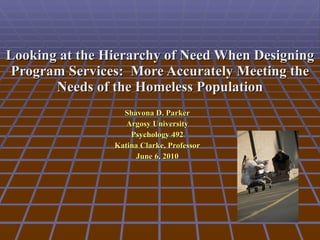
Looking At The Hierarchy Of Need When Designing
- 1. Looking at the Hierarchy of Need When Designing Program Services: More Accurately Meeting the Needs of the Homeless Population Shavona D. Parker Argosy University Psychology 492 Katina Clarke, Professor June 6, 2010
Notes de l'éditeur
- Read the introduction
- Abraham Maslow (1908-1970), a personality theorist (also known as humanistic psychology) “was most systematic in describing the structure of personality, and postulated a hierarchy of needs”. The watchword during Maslow’s time was “self-actualizing”. It was believed that we could all reach our highest potential. However, things could get in the way and block this progression. Maslow believed that, “Difficult living conditions or stressful life or interpersonal experiences may move you away from your true self” and that “we cannot progress up the hierarchy until we have satisfied the needs at lower levels”, (Barlow & Durand, 2005). The hierarchy consists of five levels…..
- The face of the homeless is not what we once thought it to be. Anyone can be homeless…single parents, 2-parent families, the disabled, the mentally ill (including depression), the drug/alcohol addicted, children, teens, the once employed…It could be you! It could be me!
- It has been shown that the homeless population presents with multi-axial issues. In the study by Best, et. al, (2008), it was found that many homeless individuals are dealing with, “multi-axial problems such as substance abuse, instability of employment, health problems and problems with family and/or relationships”. Toro, et al (1995) was consistent with most findings, “suggesting high rates of pathology of all types among the homeless, including mental illness, substance, criminal behavior and health problems”, and Fischer, et. al (1986), found that one-third of the homeless subjects were identified as likely psychiatric cases, and diagnosed with disorders such as schizophrenia, affective disorder …and particularly substance abuse.
- Here we take a look at what a program may ask of its clients, those who are dealing with multi-axial problems/issues. The goals listed here are more in line with what stable, average people are trying to do. An individual whose basic needs have not been met, will have a difficult time at adhering to these program standards. Take employment for example. In this economy, a person with an education and job history has a difficult time finding employment. Now, add substance abuse, no formal education and lack of stable housing. How easy will it be for that person to find employment?
- Let’s take a look at a fictitious client. This client presents with a lifetime of instability; and no two clients are the same. With that in mind, the Individual Service Plan & Goals set by programs need to address the unique issues facing each client. How likely to do think it is that this client is ready for employment within 90-days? The chances are slim. Programs must look at the overall picture of the clients life in determining the likelihood of success in their programs. Programs should rethink timelines on “requiring work” or “going to school” and focus closer on what the “client says that he/she needs” and if those needs are realistic. This woman may say that she wants to work and will actually look for work. However, her limited education, limited job history and long-term abuse of drug/alcohol, will present as barriers to this goal. Think of realistic goals when clients come in for service and address those immediate needs before pushing higher level needs onto clients.
- The next several slides will outline how Maslow’s Hierarchy of Needs model can be used in designing services for homeless individuals and families. First, there are the Biological & Physiological Needs, where clients are functioning in “survival mode”. This level must be addressed before clients can move on to higher level needs. Programs may want to look at extending the timeline out to about 6-months to work with clients and their primary concerns. It may not be easy to figure out what those needs are but it is safe to assume that many of the clients will have multiple issues preventing them from moving on to employment or school.
- (Read from slide)—Clients may not be able to address these issues at the start of the program so the timeline should be pushed out to 6-12 months.
- (Read from slide)---Once the client has addressed those pressing, primary issues, he/she may be ready for this level during the 2 nd half of the program.
- (Read from the slide)---By the end of a 24-month program, clients may just be settling into “normal” living, where they are working and depending less on programs for everyday living.
- By the time a client reaches this level, he/she will have long left your program and it is unfortunate that you may not see the “fruits of your labor”. But the lives that enter your programs do not belong to you. Clients have the right to make decisions for themselves. Just keep in mind that you planted the seeds; and the client has the right to nurture and maintain those seeds or let those seeds die. But many clients will go on to reach this level in their lives. The tree that sprouted from the seeds you planted are now blooming with the successes of that client….family & marriage, a new home, a college education, a new car, happiness.
- Read conclusion.